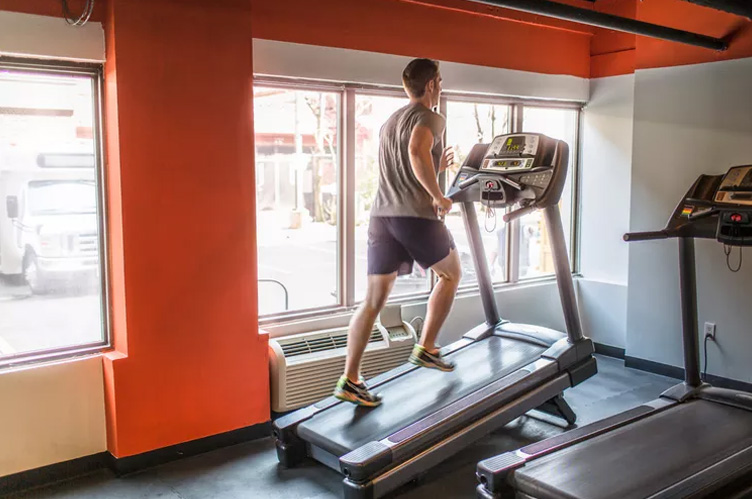Running on a Treadmill vs. Outside
 The debate over running on a treadmill vs. outside is not a new one. Running outdoors can improve stability by forcing you to navigate ever-changing terrain. But a treadmill forces you to sustain speed and performance levels that might otherwise lag outdoors.
Ultimately, there is no right or wrong answer to the debate over treadmill vs. outside running. Both methods have their pros and cons based on your individual training needs and goals and both can have their place in your running routine.
The debate over running on a treadmill vs. outside is not a new one. Running outdoors can improve stability by forcing you to navigate ever-changing terrain. But a treadmill forces you to sustain speed and performance levels that might otherwise lag outdoors.
Ultimately, there is no right or wrong answer to the debate over treadmill vs. outside running. Both methods have their pros and cons based on your individual training needs and goals and both can have their place in your running routine.
Is Running on a Treadmill Easier?
Athletes can get the same workout whether running on a treadmill or outside as long as they maintain the same level of effort. But "effort" can be a subjective measure.
Clinically speaking, effort is based not only on your heart rate but on a phenomenon known as perceived exertion. Perceived exertion refers specifically to how "hard" you consider an activity to be, irrespective of how your body responds to that activity.
Perceived exertion matters because we tend to give up sooner if something is perceived to be difficult. This psychological component can influence how much we get out of one exercise compared to the next.

However, if assessing the real, rather than perceived, benefits of running, outdoor running will usually come out on top. Even if you run at the same pace on a treadmill, you will generally expend more energy running outdoors. This difference in calorie burn is not only due to variations in terrain, weather, and wind conditions but also because the treadmill ultimately does a lot of the work for you by propelling you forward.
Treadmill Pros and Cons
| Pros | Cons |
| No weather or temperature constraints | No weather or temperature constraints |
| Easy to control pace | Can't make turns |
| Convenient | Can be boring |
| Easier on the joints |
Pros
Treadmills are one of the most popular pieces of cardiovascular equipment both at home and in gyms, thanks to the many advantages they offer.
No weather or temperature constraints
Running in inclement weather is uncomfortable, even if you dress for it. In hot weather, there is a risk of dehydration or heat exhaustion. And it's risky to run on snow and ice. Inside on a treadmill, you avoid these discomforts and risks.

If you're running at home or at the gym, you're in a climate-controlled environment and safe from any inclement weather. You also don't have to worry about sunscreen, or about over- or under-dressing and being caught far from home without the right gear.
You Can Simulate (Some) Race Conditions
If you're training for a hilly marathon, you can run hills on the treadmill even if you don't have access to a training route with hills. Study the course and plan your treadmill hills for the appropriate points.
 You can even use treadmill runs to try out race day clothing and make sure your gear will work for you.
You can even use treadmill runs to try out race day clothing and make sure your gear will work for you.
You Can Control Your Pace
Outside, it can be difficult to maintain a consistent pace. For this reason, treadmill training can be a good solution if you are coming back from an injury. The treadmill makes it easy to track your mileage and pace.
 You can also stop anytime you want. But you can also use the treadmill pace to push yourself.
You can also stop anytime you want. But you can also use the treadmill pace to push yourself.

It's Convenient
Home treadmills let you run on your own time, even in bad weather, late at night, or when you need to keep an eye on your children.
You Can Multi-Task
On a treadmill, it's safe to use headphones to listen to music or podcasts. You can watch TV or even page through a magazine or book.
It's Easier on the Joints
 Treadmills offer better shock absorption than pavement or roads, which means less stress on the ankles and knees. And when you run at an incline on the treadmill, you build strength and endurance like you would running hills outside. But you don't have to run downhill, which can be hard on your body.
Treadmills offer better shock absorption than pavement or roads, which means less stress on the ankles and knees. And when you run at an incline on the treadmill, you build strength and endurance like you would running hills outside. But you don't have to run downhill, which can be hard on your body.
You Can Run Alone and at Any Hour
Running indoors on a treadmill means you avoid the hazards of running outside. It's also safer than running outside by yourself, without a running partner or group.
Cons
While there are many benefits to choosing indoor treadmill workouts, it's important to know some of the dangers and drawbacks of treadmill running.
You Can Still Get Hurt
 While treadmills are considered the safer option by most users, the CPSC reports that there are more than 24,000 treadmill-related injuries in the U.S. each year. These include sprains, falls, head injuries,2 and cardiovascular events in people who either ran too fast or pushed too hard. (But the figures for outdoor runners are much higher.)
While treadmills are considered the safer option by most users, the CPSC reports that there are more than 24,000 treadmill-related injuries in the U.S. each year. These include sprains, falls, head injuries,2 and cardiovascular events in people who either ran too fast or pushed too hard. (But the figures for outdoor runners are much higher.)
You Can't Go Downhill
Most treadmills don't have a downward incline feature which you need to strengthen the anterior tibialis muscles at the front of your legs. If you're training for a race with lots of elevation changes, you'll want to train for downhill portions of the course as well.
You Can't Make Turns
Similarly, there are no turns on a treadmill, limiting your ability to improve your lateral agility.
Can be boring
Even with music or TV to keep you company, treadmill running for a long period of time can be tedious. While treadmills may be great for short interval runs or speed training, they can be very monotonous for hours-long running sessions.
Outside Running Pros and Cons

| Pros | Cons |
| Inexpensive | Some risk of injury |
| Prepares you for road races | Dependent on weather conditions |
| Burns more calories | Can be dangerous |
| Provides more variety |
Pros
From being outdoors with nature to people watching, there are many notable benefits of taking your run outside.
Inexpensive
Running outside is free and you aren't constricted by a gym's schedule or the availability of machines. You don't need to purchase a gym membership or a treadmill to enjoy running outdoors.
You Can Continue Training Even When Traveling
Hotels can often suggest nearby routes. Running is a great way to check out a new place. As long as you take safety precautions and use a pre-planned route, running can be a great way to explore a new destination.
 It Provides Sport-Specific Training for Road Races
It Provides Sport-Specific Training for Road Races
By running outdoors, your muscles and joints will be more conditioned to the varied terrain you'll encounter in a race. Depending on your race, train on a track, road, or trail, and you can closely mimic your final race conditions. You'll be better able to adapt to changes in weather and know when to exert extra effort when faced with elevations or known obstacles.
It Allows You to Enjoy Nature and Breathe Fresh Air
Some research has even shown that exercise is more enjoyable when it's done outside.3 And you can explore a new place more quickly and easily while running. You cover more distance, so you see more sights.
 It Can Be Motivating
It Can Be Motivating
Running outside—whether you're planning a route to the end of the block or beyond—can be encouraging. It's also fun to complete a distance goal outside. Even if you're not motivated, if you're doing an out-and-back route, you still have to complete your route to get home.
Burns more calories
Thanks to wind resistance outside, you have to work a little harder to keep up your pace, which means a greater calorie burn.
 Cons
Cons
There Is a Risk of Injury
According to research from the University of Applied Sciences in the Netherlands, knee injuries are by far the most common, followed by lower leg, foot, and ankle injuries, respectively.4 Throughout the course of an outdoor running route, you can experience different and uneven terrain, potentially increasing your risk for injury.
You're Dependent on Weather Conditions
Whether you're running in winter or summer, inclement weather can happen at any time, leaving you running outdoors in sudden rain or snow.
 Additionally, running outside means you're watching the heat and humidity index to avoid potential heat exhaustion in the hot summer months.
Additionally, running outside means you're watching the heat and humidity index to avoid potential heat exhaustion in the hot summer months.
Can be dangerous
In addition to overuse injuries, there are other hazards outside, including falls, darkness, cars, cyclists, dogs, and other people.
Making the Choice
If your sole intention is to meet and maintain your cardiovascular fitness goals, a treadmill may provide all you need. By pairing the exercise with an accurate pulse monitor, you can push yourself appropriately while keeping well within your maximum heart rate (MHR).
 On the other hand, when training for a race event, you will clearly benefit more from running outside. While you can incorporate treadmill running to improve your cardio health, experts generally recommend limiting it to no more than 40% of your overall training.
On the other hand, when training for a race event, you will clearly benefit more from running outside. While you can incorporate treadmill running to improve your cardio health, experts generally recommend limiting it to no more than 40% of your overall training.
No matter your fitness goals, remember that where you choose to run is a personal preference. If you prefer indoor running versus outdoor running, you're more likely to commit to the routine, and vice versa.
The choice between treadmill running or running outside doesn't have to be an either-or decision. When you lace up and get moving, choose the best route for you. A combination of both may work for you, and if it's practical and fits your schedule, you'll reap the benefits of each.
Frequently Asked Questions
Is a treadmill or an elliptical closer to running outside?
Both the treadmill and the elliptical are great cardio machines if you're looking to work on your endurance. However, to most closely mimic the style and impacts of outdoor running, head toward the treadmill rather than the elliptical.
The elliptical can be a helpful cross-training tool, but a treadmill can best prepare you for outdoor runs or races.
How can a beginner start running outside?
Running can be an effective way to burn calories and to add movement to your routine. The many great benefits of the sport—especially if you're doing it outdoors—are that it requires few pieces of gear and can be done virtually anywhere.
To begin running, begin with an easy run/walk method that incorporates intervals of walking between short running intervals. With time, you'll begin to increase the running intervals and decrease the in-between walks. Follow a beginner's guide to running for even more helpful tips for new runners.
What treadmill incline is equivalent to running outside?
Because the treadmill belt propels your stride forward (unlike running on the road or track), many experts and treadmill runners adjust the treadmill include to 1% to account for the belt's motion.
Cr: verywellfit.com


 It Provides Sport-Specific Training for Road Races
It Provides Sport-Specific Training for Road Races It Can Be Motivating
It Can Be Motivating Cons
Cons
